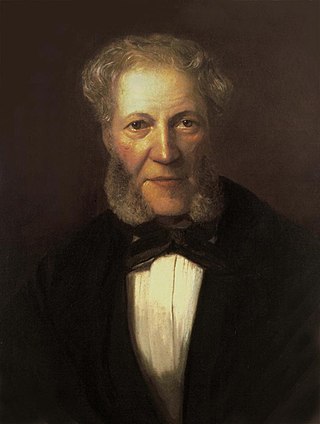
William Andrew Kinderman (born 1 November 1952) is an American author and music scholar who plays the piano. [1] [2]

William Andrew Kinderman (born 1 November 1952) is an American author and music scholar who plays the piano. [1] [2]
Born in Philadelphia, Kinderman studied music and philosophy at Dickinson College in Pennsylvania and later the same subjects at the University of Music and Performing Arts Vienna and the University of Vienna. He studied musicology at Yale University and the University of California, Berkeley. He held a professorship at the University of Victoria in British Columbia, Canada, has taught at the University of Illinois at Urbana-Champaign and currently is professor and inaugural Leo and Elaine Krown Klein Chair of Performance Studies, Herb Alpert School of Music, University of California, Los Angeles. His research focuses on Beethoven, Mozart, and Wagner. [3] He has also written on the creative process in music, and on literary subjects including Thomas Mann. His composition for piano, Bee[t]h[ov]e[n], has received performances and recordings.
Beethoven: A Political Artist in Revolutionary Times. University of Chicago Press, 2020. German edition as Beethoven. Ein politischer Künstler in revolutionären Zeiten. Vienna: Molden Verlag, 2020.

Ludwig van Beethoven was a German composer and pianist. He is one of the most revered figures in the history of Western music; his works rank among the most performed of the classical music repertoire and span the transition from the Classical period to the Romantic era in classical music. Beethoven's career has conventionally been divided into early, middle, and late periods. His early period, during which he forged his craft, is typically considered to have lasted until 1802. From 1802 to around 1812, his middle period showed an individual development from the styles of Joseph Haydn and Wolfgang Amadeus Mozart, and is sometimes characterized as heroic. During this time, he began to grow increasingly deaf. In his late period, from 1812 to 1827, he extended his innovations in musical form and expression.

The 33 Variations on a waltz by Anton Diabelli, Op. 120, commonly known as the Diabelli Variations, is a set of variations for the piano written between 1819 and 1823 by Ludwig van Beethoven on a waltz composed by Anton Diabelli. It forms the first part of Diabelli's publication Vaterländischer Künstlerverein, the second part consisting of 50 variations by 50 other composers. It is often considered to be one of the greatest sets of variations for keyboard along with Bach's Goldberg Variations.

The String Quartet No. 14 in C♯ minor, Op. 131, was completed by Ludwig van Beethoven in 1826. It is the last-composed of a trio of string quartets, written in the order Opp. 132, 130, 131.

Isaac Ignaz Moscheles was a Bohemian piano virtuoso and composer. He was based initially in London and later at Leipzig, where he joined his friend and sometime pupil Felix Mendelssohn as professor of piano in the Conservatory.

Ludwig van Beethoven is one of the most influential figures in the history of classical music. Since his lifetime, when he was "universally accepted as the greatest living composer", Beethoven's music has remained among the most performed, discussed and reviewed in the Western world. Scholarly journals are devoted to analysis of his life and work. He has been the subject of numerous biographies and monographs, and his music was the driving force behind the development of Schenkerian analysis. He is widely considered among the most important composers, and along with Bach and Mozart, his music is the most frequently recorded.

The Cello Sonata No. 3 in A major, Op. 69, is the third of five cello sonatas by Ludwig van Beethoven. He composed it in 1807–08, during his productive middle period. It was first performed in 1809 by cellist Nikolaus Kraft and pianist Dorothea von Ertmann, a student of Beethoven. Published by Breitkopf & Härtel the same year, it was dedicated to Freiherr Ignaz von Gleichenstein, Beethoven's friend and an amateur cellist. The sonata was successful with audiences from the beginning.

Ludwig van Beethoven's Piano Sonata No. 27 in E minor, Op. 90 was written in the summer of 1814 – Beethoven's late Middle period – and dedicated to Prince Moritz von Lichnowsky, a friend and benefactor who was also the dedicatee of the Eroica Variations.

The Piano Sonata No. 31 in A♭ major, Op. 110, by Ludwig van Beethoven was composed in 1821 and published in 1822. It is the middle piano sonata in the group of three that he wrote between 1820 and 1822, and is the penultimate of his piano sonatas. Though the sonata was commissioned in 1820, Beethoven did not begin work on Op. 110 until the latter half of 1821, and final revisions were completed in early 1822. The delay was due to factors such as Beethoven's work on the Missa solemnis and his deteriorating health. The original edition was published by Schlesinger in Paris and Berlin in 1822 without dedication, and an English edition was published by Muzio Clementi in 1823.

Ludwig van Beethoven's Piano Sonata No. 30 in E major, Op. 109, composed in 1820, is the third-to-last of his piano sonatas. In it, after the huge Hammerklavier Sonata, Op. 106, Beethoven returns to a smaller scale and a more intimate character. It is dedicated to Maximiliane Brentano, the daughter of Beethoven's long-standing friend Antonie Brentano, for whom Beethoven had already composed the short Piano Trio in B♭ major WoO 39 in 1812. Musically, the work is characterised by a free and original approach to the traditional sonata form. Its focus is the third movement, a set of variations that interpret its theme in a wide variety of individual ways.

Schott Music is one of the oldest German music publishers. It is also one of the largest music publishing houses in Europe, and is the second oldest music publisher after Breitkopf & Härtel. The company headquarters of Schott Music were founded by Bernhard Schott in Mainz in 1770.

Rudolph Johann Joseph Rainier, Archduke of Austria, Prince Royal of Hungary and Bohemia, Cardinal-Archbishop of Olomouc, was a member of the House of Habsburg-Lorraine, and an Austrian clergyman and noble. He was consecrated as Archbishop of Olomouc (Olmütz) in 1819 and became cardinal in the same year. Rudolph is known for his patronage of the arts, most notably as sponsor of Ludwig van Beethoven, who dedicated several of his works to him.

Franz Schubert's last three piano sonatas, D 958, 959 and 960, are his last major compositions for solo piano. They were written during the last months of his life, between the spring and autumn of 1828, but were not published until about ten years after his death, in 1838–39. Like the rest of Schubert's piano sonatas, they were mostly neglected in the 19th century. By the late 20th century, however, public and critical opinion had changed, and these sonatas are now considered among the most important of the composer's mature masterpieces. They are part of the core piano repertoire, appearing regularly on concert programs and recordings.
"Kakadu Variations" is the nickname given to Ludwig van Beethoven's set of variations for piano trio on the theme "Ich bin der Schneider Kakadu" by Wenzel Müller. The Variations was published in 1824 as Opus 121a, the last of Beethoven's piano trios to be published. The work is notable for the contrast between its solemn introduction and the lightweight variations that follow.
Joseph Czerny was a pianist, composer, music publisher, and piano teacher from the Austrian Empire. He was not related to Carl Czerny.

Julie "Giulietta" Guicciardi was an Austrian countess and briefly a piano student of Ludwig van Beethoven. He dedicated to her his Piano Sonata No. 14, later known as the Moonlight Sonata.
Wenzel Krumpholz or Václav Krumpholz was a Czech-born musician who played mandolin and violin. He studied the mandolin at an early age and became one of the most renowned performers on this instrument. At a later date he adopted the violin also, for in 1796 he was one of the first violins in the orchestra of the Court Opera, Vienna.

Johann Baptist Krall was an Austrian composer, conductor, music editor/arranger, and member of the board of directors of the Wiener Singverein of the Gesellschaft der Musikfreunde.
Birgit Lodes is a German musicologist and lecturer at the University of Vienna.
Sieghard Brandenburg was a German musicologist, who stood out especially as a Beethoven researcher.